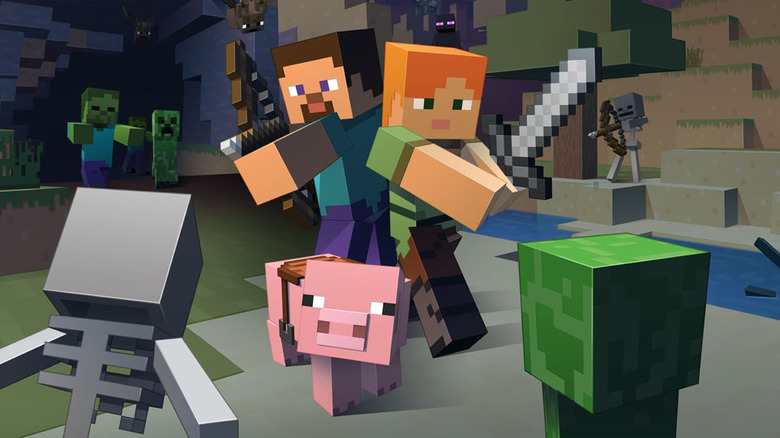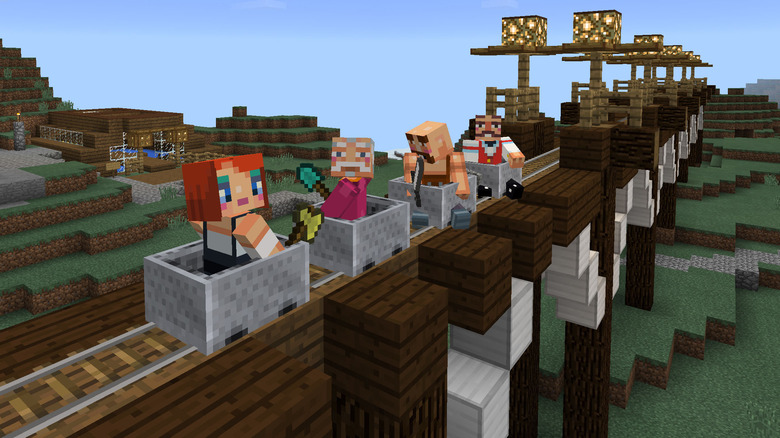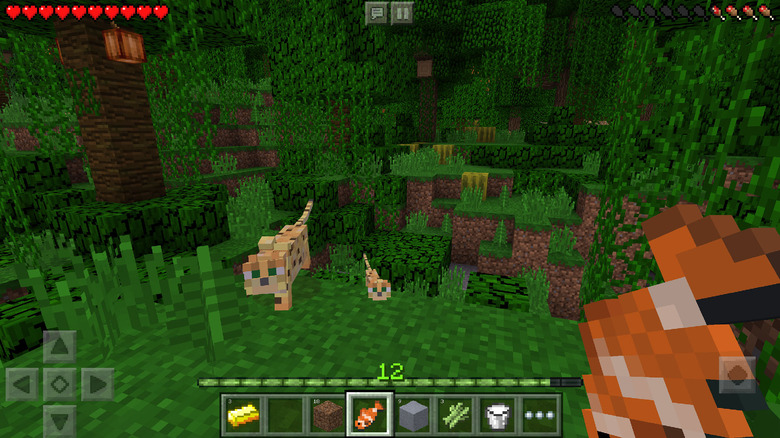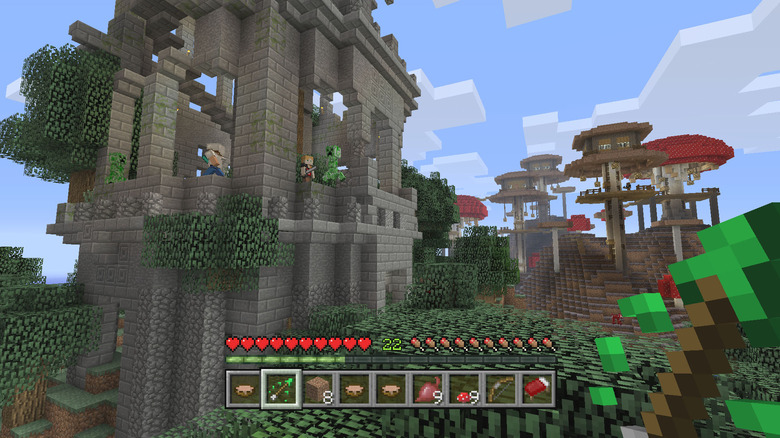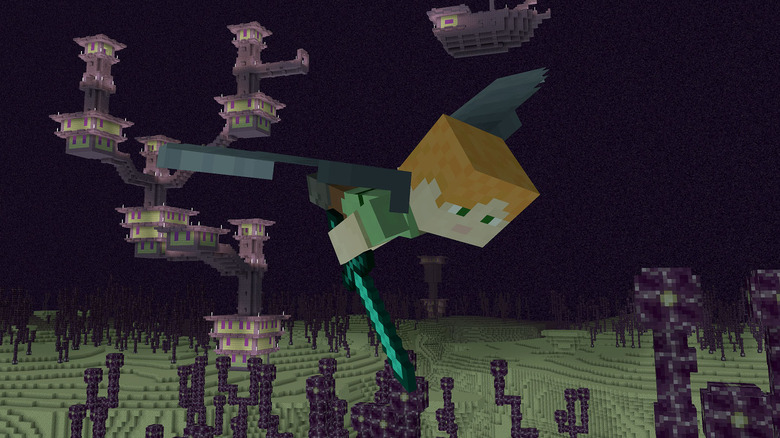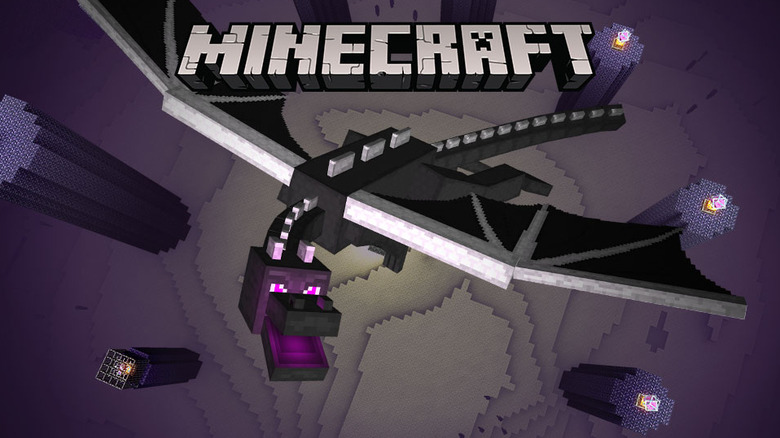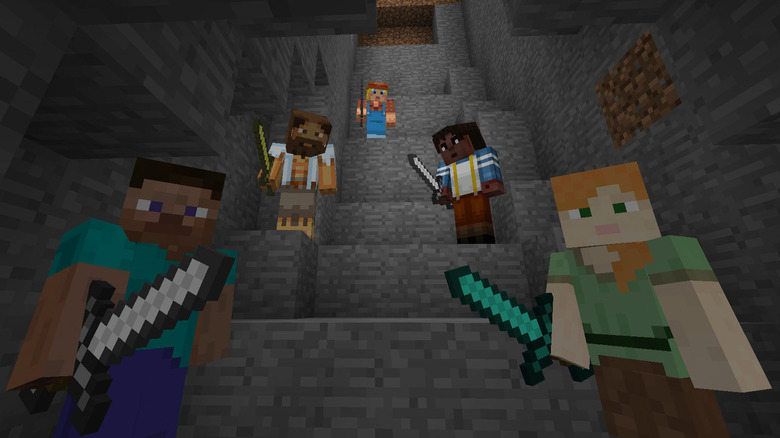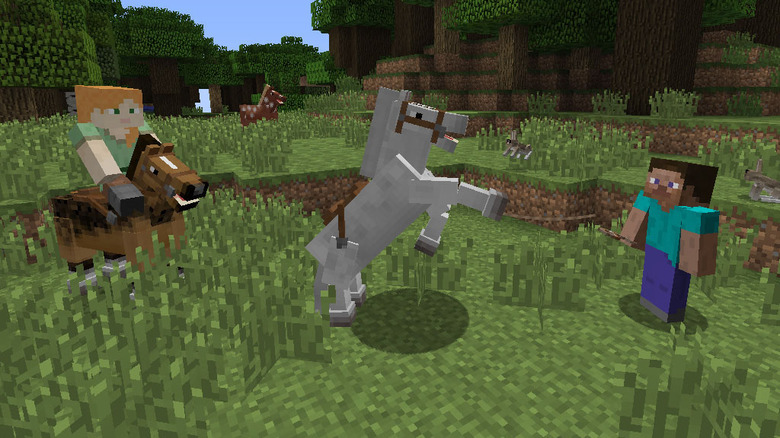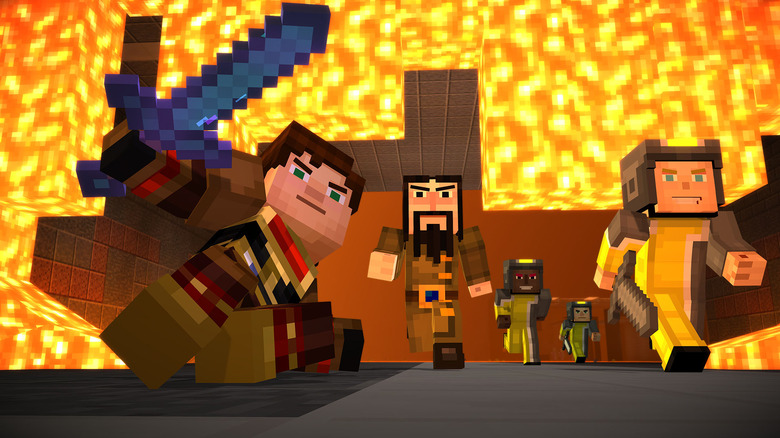The Untold Truth Of Minecraft
Unless you've been living in a cave for the better part of a decade, there's a pretty good chance that you've heard of Minecraft. Especially if you've been around kids who would probably rate the charming survival game somewhere between the invention of pizza and the second coming of Christ. There's a reason The New York Times coined the phrase "The Minecraft Generation," and that's because kids have become obsessed with the game's fully customizable environment. It's a gateway to computer programming and basic logic where you also get to fight zombies, skeletons, and dragons with awesome weapons. What's not to love?
But here's the thing: Minecraft was never intended to become a pop-culture behemoth or a kid-friendly goldmine. The smash-hit franchise originally started as a passion project for Swedish programmer Markus "Notch" Persson, who was only interested in creating a small indie title inspired by some of his favorite games. If a handful of avid PC gamers liked it and he made enough to fund development, great. If not, oh well.
Except Minecraft's success was anything but small, and the game was famously purchased by Microsoft for a whopping $2.5 billion. However, what went on behind-the-scenes wasn't exactly pretty. What follows is the untold truth of Minecraft from its development to its massive dominance of the gaming scene, and all of the messy parts in-between.
It all started with Dwarf Forest and Roller Coaster Tycoon?
In the mid-2000s, Swedish programmer Markus "Notch" Persson wanted to create his own game. He just didn't know what exactly that game would be. According to Wired, Persson wanted to make something that captured the feel of when he was a child and would race home from school to play with his LEGOs. While scouring the internet for inspiration, Persson stumbled across an odd, little text-based game called Dwarf Fortress. Playing the game became an obsession, and that's when the pieces started coming together.
In Dwarf Fortress players are tasked with strategically building strongholds out of bedrock to protect their dwarves from peril, which probably sounds like a familiar premise to fans of Minecraft. However, the game wasn't very welcoming to new players thanks to its overwhelming use of text in lieu of graphics, which is what got the wheels in Persson's head turning. While he mined Dwarf Fortress for inspiration, Wired reports that Persson also became obsessed with Roller Coaster Tycoon, particularly "the ability to build, quickly and easily, original, impressive constructions."
If only Persson could somehow fuse the two games together, or piggyback off of someone who already did.
Minecraft is an Infiniminer clone, and that's okay
In 2007, Persson abandoned development on Wurm Online and left the game in the hands of co-creator Rolf Jansson. As Wired notes, the similarities between Wurm Online and Minecraft are "unmistakable," but the former still didn't scratch that itch for Persson, so he went looking for more inspiration for his dream game. Enter Infiniminer.
Even if you had the most passing knowledge of Minecraft, it'd be impossible to ignore how closely the smash-hit resembles Infiniminer. And there's a very good reason for that. Minecraft started as an Infiniminer clone, which Persson has been upfront about since his very first test video. Here's how that worked: according to Wired, barely a month after Infiniminer was released, the game's source code was leaked online, which made purchasing it pointless as numerous variations became available for download. So Infiniminer creator Zachary Barth gave his blessing for fans to do what they want with the code. It was open source now.
One of those fans was Persson who immediately got to work molding Infiniminer into Minecraft. In Persson's defense, while the games do look remarkably alike, he made numerous changes that resulted in the Minecraft fans know and love. More importantly, Barth has no hard feelings.
"The act of borrowing ideas is integral to the creative process," he told Rock Paper Shotgun. "There are games that came before Infiniminer, and there are games that will come after Minecraft. That's how it works."
Selling Minecraft was a huge gamble
By the time Minecraft officially launched in 2011, the game had already sold over four million copies during its alpha and beta phase, according to Forbes. There was no doubt that Minecraft was going to be a sales juggernaut, but it could have just as easily dashed on the rocks when Persson made the controversial decision to charge money for copies of the game.
According to the book Minecraft: The Unlikely Tale of Markus "Notch" Persson and the Game That Changed Everything, Persson had very publicly developed Minecraft on the TGISource forum and often relied on user feedback to improve the game. Anytime he made a change, he quickly posted it online for others to dissect. Using this open development process, conventional protocol dictated that Minecraft should've been released for free and then monetization would become a concern down the road if it became a success. However, Persson decided very early on that he needed to charge for Minecraft if he wanted to truly finish the game, so he made the alpha version available for purchase at half-price.
Remarkably, his sales tactic worked, albeit a little slowly. In the first 24 hours, he only sold 15 copies, but that number quickly grew. And thankfully it did. With a steady cash flow pouring in and fans of the game accumulating by the day, Persson could afford to really make Minecraft sing. And, boy, did he ever.
The Anvil update made the in-game world crazy huge
As Minecraft continued to expand past its initial fanbase of programming and PC gaming enthusiasts, the in-game world also grew to a ridiculously enormous size. According to Mic, the fully customizable, sharable, you name it-able world of Minecraft is eight times the surface of the Earth. Reaching that size was absolutely critical to the game's growing success, as it offered more room for exploration, building, and cooperative play, all of which are hallmarks to Minecraft's popularity. And truly hardcore fans can tell you what made the explosion of in-game real estate possible.
"Aside from the very early additions to the game, I've watched the whole thing evolve as I played," computer engineer and longtime player Aaron Goers told Mic. "As far as big software changes, the largest and likely most underappreciated was their change to what they called the Anvil database system."
Introduced in 2012, Anvil was a major overhaul to how Minecraft processed data, and the result was a "much bigger and faster" world that millions of players are still getting lost in to this day. With this breakthrough in technology, Minecraft was unstoppable, but behind-the-scenes, its creator's life was anything but.
Minecraft soared while Persson's personal life crumbled
As Minecraft became a smash hit in the gaming community and millions flocked to Persson's passion project, you'd assume the Swedish programmer would be ecstatic with the results of his creation. But things were anything but rosy behind the scenes. In interviews Persson has never shied away from the details of his childhood, which included a drug-addicted father who bounced in and out of prison. However, Persson and his father reconciled, and according to Rolling Stone, Persson's dad was an instrumental pillar of support during the early days of Minecraft and encouraged his son to follow his dream.
But just as Minecraft officially launched after a phenomenal alpha and beta period, tragedy struck. While Persson's father was extremely supportive of his son's gaming ambitions, he was also abusing prescription medication, which caused a relapse of his alcoholism. On December 14, 2011, Persson's father committed suicide following a heavy night of drinking.
Earlier that same year, Persson had also married his longtime girlfriend Elin Zetterstrand. But their marriage didn't make it past a year, which Persson blames on his newfound success with Minecraft. Following the collapse of his marriage and his father's suicide, Persson pulled the plug on a game that was rumored to be his big follow-up to Minecraft. The weary programmer felt "hounded by expectations" to match Minecraft's success, which was about to become bigger than anyone could've imagined.
The $2.5 billion sale to Microsoft left heads scratching
On September 15, 2014, Microsoft shocked the game industry by purchasing Persson's game studio Mojang for $2.5 billion. But it was very clear what Microsoft was really buying: Minecraft. However, the purchase was surprising for a number of reasons, not the least of which was that gaming analysts didn't think Minecraft was worth that much money. Yes, the game was a massive success, but $2.5 billion is a lot for just one intellectual property. On top of that, Persson had boasted that he'd never sell his creation to "big, evil corporations." Obviously, he didn't stick to that promise, and in an interview with Forbes, he doesn't seem particularly bothered about how that decision made him look.
"Well, I guess I have to eat those words," Persson said. "I don't really have a big problem about that because people change their mind about things all the time. You have to be responsible for what you said of course, but I don't really feel like a lot of shame for saying something that I've changed my mind about."
As for what changed his mind – besides the insanely large purchase price – Persson wanted out. He was done with Minecraft. More specifically, he was done answering to fans who had just made him one of the wealthiest names in gaming.
Minecraft's success was overwhelming for Notch
Following the news that Microsoft now owned his passion project, Persson took to his now-defunct blog to let fans know that he was washing his hands of Minecraft and exiting Mojang altogether. He had never planned to create a game that became as popular as Minecraft did, and quite frankly, the whole experience made him miserable.
"I've become a symbol," Persson wrote. "I don't want to be a symbol, responsible for something huge that I don't understand, that I don't want to work on, that keeps coming back to me. I'm not an entrepreneur. I'm not a CEO. I'm a nerdy computer programmer who likes to have opinions on Twitter."
Persson also vowed that if he "accidentally" makes something that starts to gain traction like Minecraft, he'll abandon it immediately. Yikes. He also addressed rumors that he sold out by ceding control of Minecraft to Microsoft. According to Persson, the decision to sell was about his "sanity" not the money. And while there's probably a sizable kernel of truth to that statement, Persson didn't exactly shy away from his suddenly much larger bank account.
From indie game maker to crazed socialite
If Persson wanted to shut down "haters" who accused him of selling out to Microsoft, he couldn't have handled it worse. Flush with cash, the Minecraft creator is often spotted partying across the globe when he isn't living in his Beverly Hills mansion. It also doesn't help that he spends much of his time on social media complaining that his new, opulent lifestyle is "hell" and that money has "ruined" him, according to the Daily Mail. We'll gladly take some off Persson's hands if it'll make things easier for him.
On top of becoming an apparently tortured socialite, Persson wasn't joking when he told fans that he just wanted to spout opinions on Twitter. Unfortunately, some of those opinions aren't exactly the best, and they grew exponentially worse following the election of Donald Trump. In 2017, the Daily Beast reports that Persson found himself in hot water after using misogynistic language towards a female game critic and even hotter water after he seemingly endorsed both the Pizzagate and Seth Rich conspiracy theories. The former accuses Hillary Clinton of running a secret pedophile ring in the basement of a pizza shop (which doesn't even have a basement), while the latter accuses her campaign of murdering staffer Seth Rich because he was allegedly sharing information with WikiLeaks (he was not).
At this point, it's probably a good thing that Persson stepped away from Minecraft. The series' future is bright, and its creator's drama would only slow it down.
The future of Minecraft couldn't be stronger
Despite the fact that it's almost been around for an entire decade, Minecraft has shown no signs of slowing down. PC Gamer reports that the blockbuster franchise had 74 million active users in December 2017 and has sold over 144 million copies. To put things in perspective, PlayerUnknown's Battlegrounds, which was one of the most popular online games of 2017, only has an active user base of about 30 million. Needless to say, Minecraft is crushing it.
But the series isn't resting on its laurels. Minecraft has a huge graphics update and an underwater expansion planned for 2018, according to Engadget, both of which will only bolster the game's popular appeal that keeps gamers coming back for more. And with a Hollywood movie in the works that will almost certainly capture the imagination of the next generation of gamers, that's a whole new audience waiting in the wings to grab a pickaxe and start mining.

